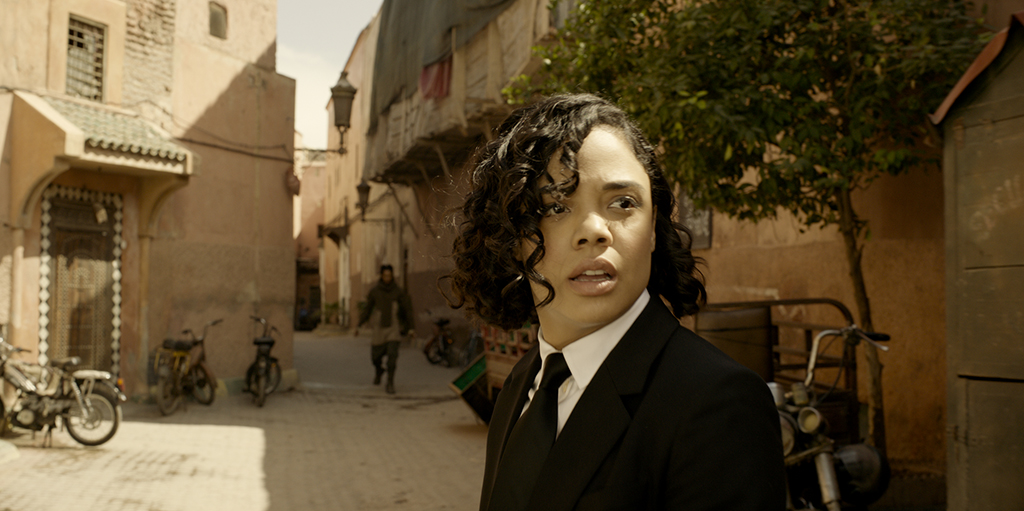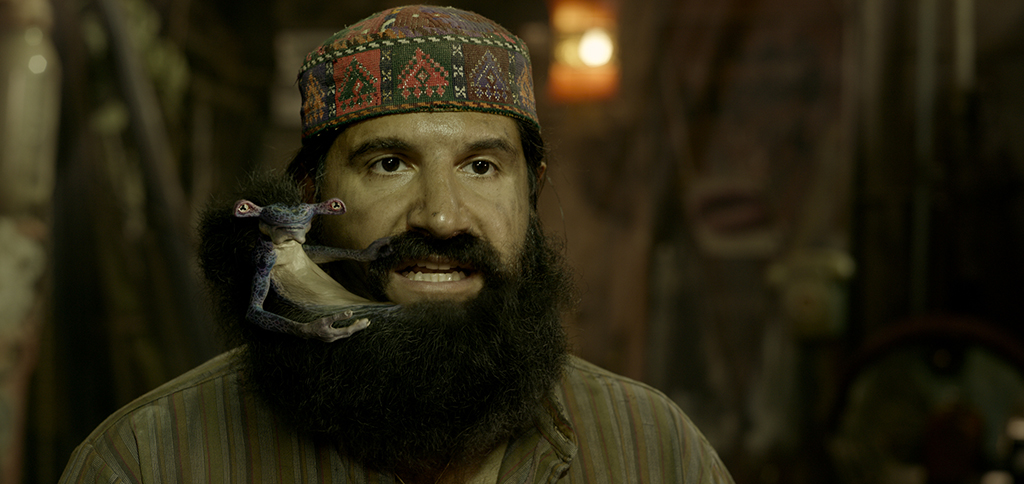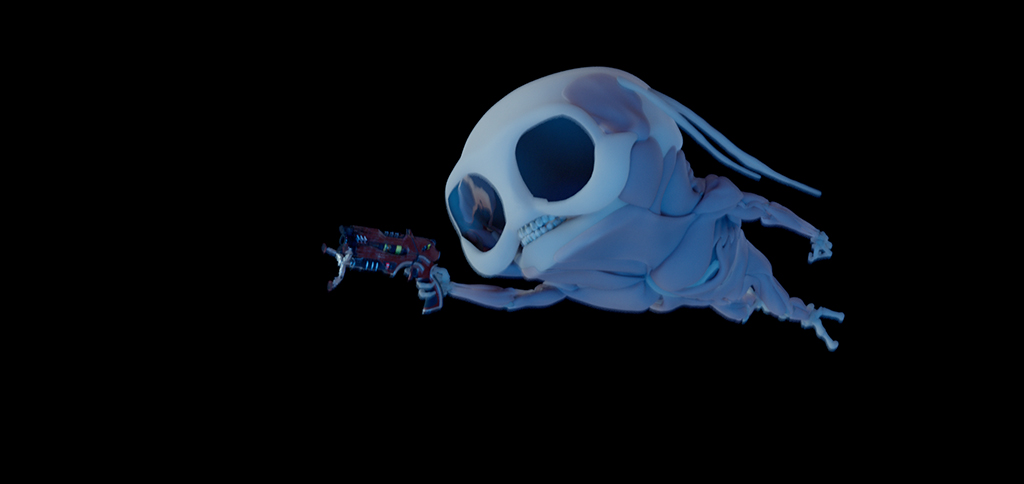By TREVOR HOGG

By TREVOR HOGG

Alien beings attempting to blend into Earthly society by adopting human and animal forms and traits are a signature of the Men in Black franchise and served as guiding principle when designing the 36 different creatures. In the spin-off installment Men in Black: International, MiB Agents H (Chris Hemsworth) and M (Tessa Thompson) encounter both friendly and hostile visitors from other planets in their efforts to obtain a weapon of mass destruction.
“There was quite a bit of prosthetics in the Men in Black London scenes, especially in headquarters,” notes Daniel Kramer, who shared Production Visual Effects Supervisor duties with Sony Pictures Imageworks colleague Jerome Chen. “In some of those cases they were augmented to give them more motion than what existed in the plate. For most of the characters that have speaking parts and a lot of motion we generally replaced completely in CG.”
Famous French dancing-duo siblings Laurent and Larry Bourgeois star as the Twins, adversarial celestial beings with the ability to manipulate matter. “One of the big challenges was figuring out the Twins and what their characters were going to be,” explains Kramer. “The idea was that they were these aliens that are pure energy, almost nebula-like in their pure form. The Twins have the ability to shape-shift into other matter and shape-shift matter into new shapes. They can warp asphalt into a weapon or create a street wave. The Twins can use that ability as a defensive or offensive power. The two of them need to be in a certain proximity with each other to activate these powers.”
“That’s always exciting when you see audiences connect to a digital character like that and accept it as part of the world.”
—Daniel Kramer, Production Visual Effects Supervisor, Sony Pictures Imageworks


Both DNEG and Method Studios had sequences with the Twins. “The look of the Twins was established by DNEG, but all of their stuff was set at night, whereas our scenes were set under heavy key-light day conditions,” states Method Studios Visual Effects Supervisor Hamish Schumacher. “We had to come up with a different look.” DNEG provided Houdini simulation files to Method Studios; however, there were a lot of custom shaders and proprietary tools involved so the nebula effect had to be created from scratch.




“One thing that we shared between us and DNEG,” says Schumacher, “was the circulatory system inside of the Twins that is surrounded by this nebulas form. At nighttime the nebulas form is self-illuminated. For the daylight scenes we came up with more of a pyroclastic cloud surrounding the Twins and used that to put the image inside so we had something to silhouette it against. The eyes and a lot of the characteristics are the same within the twins.” A trial and error approach was adopted for the nebula simulation. “Sometimes the nebula surrounding the Twins would be moving too fast, or the next time it might not be moving fast enough. It was finding that sweet spot to give it scale. Otherwise it feels that the Twins aren’t powerful enough or too powerful.”
“Pawny [Kumail Nanjiani] was one of the characters that early on everybody was happy with the general design and was a straightforward character, so we didn’t struggle very much with him,” notes Kramer. “We did have facial capture for some of it and were able to use other reference material from Silicone Valley of Nanjiani.” Some complications developed along the way with the chess-piece-sized alien developed by Sony Pictures Imageworks and Method Studios. “There are numerous times that Pawny rides on M’s shoulder, and she has quite a lot of hair,” states Method Studios Visual Effects Supervisor Glenn Melenhorst. “We wanted him to have some jiggle and sway when M was walking around. But if you did that too much Pawny looked like he was off-balance all of the time. It was also how do you get him authentically on her shoulder and being bounced around but still delivering lines? The tiniest shoulder shrug, when you’re a character that small, would almost throw him off her shoulder. How does he stick on?” As much as Pawny has suction cup feet sometimes it was a conceit that he would retain his balance during some shots. “We did keyframe for everything,” says Melenhorst. “There’s a point where creatures start to look a bit odd when they’re mocap with human biomechanics. You get a creature only meant to be as big as Pawny, put a natural human gait and arm swing and sway to it, and the scale looks off.” Pawny had a human shaped mouth that helped with the dialogue. “The face shapes were standard and human.”




“The living beard, Bassam, was probably the biggest creative challenge since he was so unique,” notes Method Studios Visual Effects Supervisor Seth Hill. “Trying to find a way to have a little creature curl up under a person’s chin and sit into a slight cavity under their jaw and blend perfectly into being a real beard turned out to be much more technically and aesthetically challenging than perhaps at first glance. The challenge is all in the details of how do you animate this creature to feel like it peels away? How does a beard blend perfectly into the hairless face of the host? How do you provide the required room for the beard to feel like its own emotive character when it’s half attached to a person’s face? As we started encountering these questions, we would have to evaluate how we rigged the creature or were planning on simulating its hair and adjust from there. In the end, the rig we built was rather flexible in its ability to conform and stretch away from the character’s face that Bassam sat on, along with some really clever animation led by our Montreal animation supervisor, Jye Skinn. Once all that was in place, it came down to some really clever comping to pull it all together.”






Agents H and M encounter Vungus the Ugly at a nightclub where humans and aliens mingle together. “Kayvan Novak, who portrayed Vungus, is an engaging actor and did a great performance,” remarks Kramer. “Everybody fell in love with his banter between Chris and Tessa. There was a worry that we were not going to be able to capture that charm and behavior exactly right in CG and lose that performance. We went through a lot of different designs to figure out what he would look like. Vungus was suppose to be ugly but also charming and the life of the party. We did talk about how “alien” we should make him. If we made Vungus too alien where he diverted from the basic structure of a human face of two eyes and a mouth, it may have been difficult to portray the performance of Kayvan properly and bring that emotion across.” The character produced by DNEG is a personal favorite. “I like the nightclub with Vungus. The same with Pawny, which is interacting, feels believable and is getting laughs. That’s always exciting when you see audiences connect to a digital character like that and accept it as part of the world.”





“There are numerous times that Pawny rides on M’s shoulder, and she has quite a lot of hair. We wanted him to have some jiggle and sway when M was walking around. But if you did that too much Pawny looked like he was off-balance all of the time. It was also how do you get him authentically on her shoulder and being bounced around but still delivering lines? The tiniest shoulder shrug when you’re a character that small would almost throw him off her shoulder. How does he stick on?”
—Glenn Melenhorst, Visual Effects Supervisor, Method Studios

